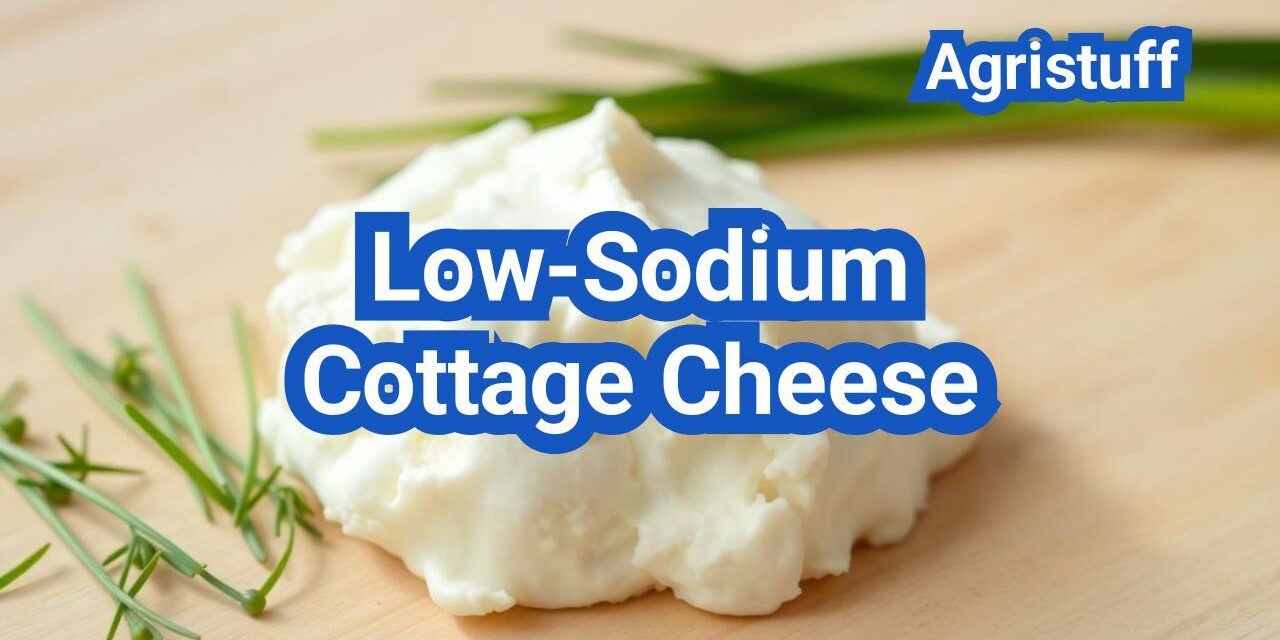This article does not contain medical advice
Cottage cheese has long been a staple in many diets due to its high protein content and versatility. However, traditional cottage cheese can be high in sodium, which may be a concern for those monitoring their salt intake. As a result, low-sodium cottage cheese has gained popularity among health-conscious consumers.
The shift towards lower sodium options reflects a broader trend towards healthier eating. Consumers are becoming more aware of the importance of managing sodium intake, and manufacturers are responding by offering a range of low-sodium products.
Understanding the processing, brands, tips, and taste of low-sodium cottage cheese can help consumers make informed choices. This article will explore these aspects in detail, providing insights into the world of low-sodium cottage cheese.
Key Takeaways
- Low-sodium cottage cheese is a healthier alternative to traditional cottage cheese.
- Several brands offer low-sodium cottage cheese options.
- Processing methods can affect the taste and nutritional content.
- Tips for incorporating low-sodium cottage cheese into your diet.
- The taste profile of low-sodium cottage cheese can vary between brands.
What Makes Cottage Cheese “Low-Sodium”
The term ‘low-sodium’ is often associated with healthier eating, but what does it really mean when it comes to cottage cheese? To understand this, we need to delve into the differences between standard and low-sodium cottage cheese, the guidelines set by the FDA for ‘low-sodium’ labeling, and the health benefits associated with reducing sodium intake.
Standard vs. Low-Sodium Cottage Cheese Comparison
Standard cottage cheese typically contains higher amounts of sodium due to the addition of salt during processing. This salt not only enhances flavor but also acts as a preservative. In contrast, low-sodium cottage cheese has less sodium, achieved through reduced salt addition or alternative preservation methods.
| Cottage Cheese Type | Sodium Content (mg per 1/2 cup) |
|---|---|
| Standard | 350-450 |
| Low-Sodium | 50-140 |
FDA Guidelines for “Low-Sodium” Labeling
The FDA has specific guidelines for labeling products as ‘low-sodium’. To qualify, a product must contain 140mg or less of sodium per serving. This guideline helps consumers make informed choices about their sodium intake.
“The FDA’s sodium labeling guidelines are crucial for helping consumers reduce their sodium intake, which is linked to lower blood pressure and reduced risk of heart disease.”
Health Benefits of Reducing Sodium in Dairy
Reducing sodium intake, particularly in dairy products like cottage cheese, can have significant health benefits. Lower sodium consumption is associated with reduced blood pressure and a lower risk of cardiovascular diseases.
Key Health Benefits:
- Lower Blood Pressure
- Reduced Risk of Heart Disease
- Less Strain on Kidneys
By choosing low-sodium cottage cheese, consumers can enjoy the nutritional benefits of cottage cheese, including high protein content, while minimizing sodium intake.
The Science Behind Low-Sodium Cottage Cheese Processing

Low-sodium cottage cheese processing requires a deep understanding of both traditional cheese-making methods and modern sodium reduction techniques. The production of cottage cheese involves curdling milk, which is then cut into curds, drained, and often washed to remove excess whey and lactose.
Traditional Cottage Cheese Production Methods
Traditionally, cottage cheese is made by adding a bacterial culture to milk, which ferments the lactose and produces lactic acid, causing the milk to curdle. The curds are then cut, cooked, and washed to remove whey and achieve the desired consistency. Sodium chloride (salt) is typically added to enhance flavor and aid in preservation.
Sodium Reduction Techniques in Manufacturing
To reduce sodium in cottage cheese, manufacturers employ several strategies. One common method is to simply reduce the amount of salt added during production. Another approach involves using flavor enhancers that can compensate for the loss of salt without adding sodium. Some manufacturers also experiment with different types of salt or salt substitutes that have lower sodium content.
Salt Alternatives Used in Commercial Production
Various salt alternatives are used in commercial low-sodium cottage cheese production. These include potassium chloride, which can mimic the flavor of salt without the sodium, and other natural flavorings that enhance taste without adding salt. Some brands also use sea salt or Himalayan pink salt, which have coarser textures and potentially lower sodium content by volume compared to refined salt.
The use of these alternatives allows consumers to enjoy cottage cheese with reduced sodium while maintaining the product’s characteristic taste and texture. As consumers become more health-conscious, manufacturers continue to innovate and improve their sodium reduction techniques.
Nutritional Profile of Low-Sodium Cottage Cheese
Understanding the nutritional profile of low-sodium cottage cheese is crucial for health-conscious consumers. This dairy product is not only a good source of protein but also contains various essential nutrients.
Complete Nutrition Facts Breakdown
Low-sodium cottage cheese is rich in nutrients, making it a valuable addition to a balanced diet. A typical serving size (1 cup) provides:
- Protein: 28-30 grams
- Fat: 2-5 grams (varies based on the type, e.g., low-fat or non-fat)
- Carbohydrates: 5-8 grams
- Calcium: 80-100 mg
- Sodium: Significantly reduced compared to regular cottage cheese, typically less than 50 mg per 1/2 cup serving
Protein, Fat, and Carbohydrate Content
The nutritional content of low-sodium cottage cheese makes it an attractive option for those monitoring their sodium intake. The high protein content supports muscle health, while the low fat content makes it suitable for those on a low-fat diet.
Protein Content: Cottage cheese is renowned for its high protein content, which is essential for muscle repair and growth. The protein in cottage cheese is considered complete, meaning it contains all nine essential amino acids.
Sodium Content Comparison Chart
Comparing the sodium content of low-sodium cottage cheese with regular cottage cheese highlights the significant reduction in sodium:
| Type of Cottage Cheese | Sodium Content per 1/2 cup serving |
|---|---|
| Regular Cottage Cheese | 350-450 mg |
| Low-Sodium Cottage Cheese | Less than 50 mg |
This comparison underscores the benefits of choosing low-sodium cottage cheese for those looking to reduce their sodium intake.
Best Low-Sodium Cottage Cheese Brands in the U.S.
Several national and regional brands offer high-quality low-sodium cottage cheese options in the United States. These brands cater to the growing demand for healthier dairy products with reduced sodium content.
National Brands with Low-Sodium Options
National brands have been quick to adapt to consumer preferences for lower sodium content. Some of the prominent national brands offering low-sodium cottage cheese include:
- Daisy: Known for their high-quality dairy products, Daisy offers a low-sodium cottage cheese option that doesn’t compromise on taste.
- Friendship: Friendship is a well-established brand in the cottage cheese market, offering a low-sodium version that is popular among health-conscious consumers.
- Organic Valley: For those looking for organic options, Organic Valley provides a low-sodium cottage cheese that is both organic and sustainably produced.
Regional and Store Brands
In addition to national brands, several regional and store brands offer low-sodium cottage cheese, often catering to local tastes and preferences. Some notable examples include:
- Trader Joe’s: Trader Joe’s offers a low-sodium cottage cheese that is popular among its customers, providing a budget-friendly option without compromising on quality.
- Target’s Market Pantry: Target’s in-house brand, Market Pantry, offers a low-sodium cottage cheese, providing customers with a store-brand alternative.
- Whole Foods Market 365: Whole Foods’ store brand, 365, offers a low-sodium cottage cheese option that aligns with the store’s quality standards.
These brands, both national and regional, are making it easier for consumers to find low-sodium cottage cheese that fits their dietary needs and preferences.
Where to Buy Low-Sodium Cottage Cheese
Low-sodium cottage cheese is now widely available in several types of stores and online platforms, making it easier for consumers to incorporate this healthier dairy option into their diets.
Major Supermarket Availability
Most major supermarkets carry low-sodium cottage cheese options. Some of the national brands that typically stock this product include:
- Walmart
- Target
- Kroger
- Safeway
- Whole Foods Market
These supermarkets usually place low-sodium cottage cheese in the dairy or health food section. It’s advisable to check the product labels or the store’s website for specific availability.
Specialty Health Food Stores
Specialty health food stores are another excellent source for low-sodium cottage cheese. Stores like:
- Whole Foods Market
- Sprouts Farmers Market
- Trader Joe’s
- Earth Fare
often carry a variety of low-sodium dairy products, including cottage cheese from brands that specialize in healthier or organic options.
Online Shopping Options and Delivery Services
For those who prefer shopping online or have difficulty finding low-sodium cottage cheese in local stores, there are several online shopping options available:
- Amazon: Offers a wide selection of low-sodium cottage cheese brands, often with the option for Prime delivery.
- Instacart: Partners with various local stores to deliver low-sodium cottage cheese to customers.
- Peapod: Another grocery delivery service that may carry low-sodium cottage cheese options.
Shopping online can be particularly convenient, as it allows consumers to read product reviews and compare prices easily.
How to Make Homemade Low-Sodium Cottage Cheese
Creating your own low-sodium cottage cheese at home can be a rewarding experience, allowing you to control the ingredients and flavor. This process not only helps in reducing sodium intake but also ensures that you’re consuming a product free from unwanted additives.
Required Ingredients and Equipment
To make homemade low-sodium cottage cheese, you’ll need the following ingredients and equipment:
- 1 quart of low-fat or nonfat milk
- 1/4 cup of white vinegar or lemon juice
- A pinch of salt (use a low-sodium salt if desired)
- A large pot
- A thermometer
- Cheesecloth or a clean, thin kitchen towel
- A colander
Step-by-Step Preparation Process
Follow these steps to make your homemade low-sodium cottage cheese:
- Pour the milk into a large pot and heat it over medium heat until it reaches 100°F to 110°F.
- Remove the pot from the heat and stir in the vinegar or lemon juice. Let it sit for about 5 minutes, or until the milk has fully curdled.
- Line a colander with cheesecloth or a clean kitchen towel, and place it over a large bowl.
- Carefully pour the curds and whey into the cheesecloth-lined colander.
- Let the mixture drain for 30 to 60 minutes, or until it reaches the desired consistency.
- Rinse the curds with cold water to remove any remaining whey.
- Gather the edges of the cheesecloth and give the curds a gentle squeeze to remove excess liquid.
- Transfer the cottage cheese to a bowl, add a pinch of low-sodium salt if desired, and mix well.
Tips for Achieving the Right Texture and Curd Size
The texture and curd size of your homemade cottage cheese can be adjusted based on your preference:
- For a creamier texture, let the curds drain for a shorter time.
- For a drier texture, let the curds drain for a longer time.
- To achieve smaller curds, cut the curds before draining.
- Experiment with different types of milk (e.g., whole, low-fat, or nonfat) to find your preferred taste and texture.
Storage Guidelines and Shelf Life
Proper storage is crucial to maintaining the quality and safety of your homemade low-sodium cottage cheese:
- Store the cottage cheese in an airtight container in the refrigerator.
- Keep it at a consistent refrigerator temperature below 40°F (4°C).
- Use within 3 to 5 days of making.
- Do not freeze, as this can affect the texture and quality.
Understanding Low-Sodium Cottage Cheese Taste

Low-sodium cottage cheese presents a unique taste experience that is both a challenge and an opportunity for culinary exploration. The reduction of sodium significantly alters its flavor profile compared to traditional cottage cheese.
Flavor Characteristics Without Added Salt
The flavor of low-sodium cottage cheese is often described as milder and less salty. This change can be attributed to the reduced sodium content, which affects the overall taste perception.
Key flavor characteristics include:
- Mildness
- Less pronounced tanginess
- A cleaner dairy taste
Texture Considerations and Variations
The texture of low-sodium cottage cheese can vary, with some brands offering a creamier consistency than others. The texture is influenced by the manufacturing process and the type of milk used.
| Texture Type | Description |
|---|---|
| Curdy | Traditional cottage cheese texture with visible curds |
| Creamy | Smoother and more blended texture |
Common Taste Complaints and Solutions
Some consumers find low-sodium cottage cheese too bland or unappetizing. To address this, various flavor enhancers can be used, such as fruits, herbs, or spices.
Common complaints and potential solutions:
- Too bland: Add fruit or nuts
- Lacking depth: Use herbs or spices for added flavor
How to Make Low-Sodium Cottage Cheese Taste Better

While reducing sodium in cottage cheese can affect its taste, various sweet and savory options can improve its flavor profile. Low-sodium cottage cheese provides a versatile canvas for a variety of flavors, making it easy to incorporate into your diet without sacrificing taste.
Sweet Flavor Enhancements
Sweetening low-sodium cottage cheese can be achieved through several methods. Adding fresh or dried fruits such as berries, peaches, or pineapple can naturally enhance the flavor. You can also use honey, maple syrup, or agave nectar in moderation to add sweetness without overpowering the cheese.
For a more indulgent treat, try mixing in some cinnamon or vanilla extract. These spices can complement the creamy texture of cottage cheese while adding a warm, comforting flavor. Additionally, using fruit preserves or jam can provide a sweeter taste without adding refined sugars.
Savory Flavor Boosters
For those who prefer savory flavors, there are numerous options to enhance the taste of low-sodium cottage cheese. Adding herbs and spices such as chives, parsley, or dill can provide a fresh, aromatic flavor. You can also mix in some garlic powder or onion powder to add depth to the cheese.
Another option is to incorporate diced vegetables like bell peppers, cucumbers, or tomatoes. These additions not only enhance the flavor but also increase the nutritional value of your snack or meal. For a more robust taste, try mixing in some smoked paprika or a sprinkle of grated Parmesan cheese.
Low-Sodium Cottage Cheese for Special Diets

For individuals following specific dietary regimens, low-sodium cottage cheese offers a nutritious and adaptable option. Its unique nutritional profile makes it an excellent choice for various special diets.
DASH Diet Integration and Guidelines
The DASH (Dietary Approaches to Stop Hypertension) diet emphasizes reducing sodium intake and increasing consumption of nutrient-rich foods. Low-sodium cottage cheese fits perfectly into this eating plan, providing a rich source of protein, calcium, and other essential nutrients.
To incorporate low-sodium cottage cheese into your DASH diet, consider the following guidelines:
- Consume 1-2 servings (1/2 cup to 1 cup) per day
- Pair it with fruits, vegetables, and whole grains
- Use it as a protein source in place of higher-sodium alternatives
Low-Sodium Cottage Cheese for Heart Health
Low-sodium cottage cheese is beneficial for heart health due to its low sodium content and high levels of potassium, calcium, and protein. These nutrients help regulate blood pressure and support overall cardiovascular well-being.
Key benefits for heart health include:
- Lowering blood pressure through reduced sodium intake
- Supporting healthy blood vessel function with potassium
- Providing essential nutrients for overall heart health
Incorporating into Kidney-Friendly Meal Plans
For individuals with kidney disease, managing sodium intake is crucial. Low-sodium cottage cheese can be a valuable addition to kidney-friendly meal plans, offering high-quality protein and essential nutrients while keeping sodium levels in check.
When incorporating low-sodium cottage cheese into kidney-friendly diets, consider the following:
- Monitor protein intake according to individual needs
- Balance with other low-sodium, nutrient-rich foods
- Consult with a healthcare provider or dietitian for personalized guidance
Weight Management and High-Protein Diets
Low-sodium cottage cheese is an excellent addition to high-protein diets aimed at weight management. Its high protein content helps promote satiety, supporting weight loss efforts and maintaining muscle mass.
Tips for using low-sodium cottage cheese in weight management:
- Use it as a base for high-protein snacks or meals
- Combine with fruits or vegetables for a satisfying snack
- Incorporate into meal plans as a protein-rich alternative to higher-sodium options
Low-Sodium Cottage Cheese for High Blood Pressure Management

Low-sodium cottage cheese is emerging as a valuable component in the management of high blood pressure. High blood pressure, or hypertension, is a significant risk factor for cardiovascular diseases, and dietary modifications play a crucial role in its management.
Connection Between Sodium and Hypertension
The link between sodium intake and high blood pressure is well-established. Excessive sodium consumption can lead to increased blood pressure in some individuals, as it can cause the body to retain fluid, putting extra pressure on blood vessels.
Reducing sodium intake is often recommended as a first-line approach to managing hypertension. The American Heart Association suggests limiting sodium intake to less than 2,300 milligrams per day, with an ideal limit of no more than 1,500 milligrams per day for most adults.
Benefits of Low-Sodium Dairy Choices
Choosing low-sodium dairy products like cottage cheese can be beneficial for those managing high blood pressure. Low-sodium cottage cheese not only reduces overall sodium intake but also provides essential nutrients like protein, calcium, and potassium, which are important for heart health.
“A diet rich in potassium can help lower blood pressure by balancing out the effects of sodium.”
American Heart Association
Recommended Serving Sizes and Frequency
To effectively incorporate low-sodium cottage cheese into a hypertension management diet, it’s essential to consider serving sizes and frequency. A typical serving size is about 1/2 cup or 110g.
| Serving Size | Sodium Content | Frequency |
|---|---|---|
| 1/2 cup (110g) | Less than 200mg | 2-3 times a week |
| 1 cup (220g) | Less than 400mg | 1-2 times a week |
Combining with Other Blood Pressure-Friendly Foods
Combining low-sodium cottage cheese with other heart-healthy foods can enhance its benefits. Foods rich in fiber, potassium, and omega-3 fatty acids, such as fruits, vegetables, whole grains, and fatty fish, can complement low-sodium cottage cheese in a balanced diet.
For example, pairing low-sodium cottage cheese with sliced fruits or vegetables can make for a nutritious snack. Additionally, incorporating it into meals with whole grains and lean proteins can provide a balanced and satisfying diet.
Delicious Low-Sodium Cottage Cheese Recipes

Cottage cheese, when chosen in its low-sodium form, offers a flexible canvas for culinary creativity. This versatile ingredient can be incorporated into a wide range of dishes, from breakfast staples to satisfying dinners.
Breakfast Ideas
Starting your day with a nutritious breakfast is easy when you have low-sodium cottage cheese on hand. Here are some delicious breakfast ideas:
- Cottage Cheese Pancakes: Mix low-sodium cottage cheese with eggs, oats, and a touch of honey for a protein-packed breakfast.
- Fruit Parfait: Layer low-sodium cottage cheese with fresh berries and granola for a healthy, filling breakfast.
- Breakfast Burrito: Combine low-sodium cottage cheese with scrambled eggs, spinach, and wrap in a whole-grain tortilla.
Lunch and Dinner Applications
Low-sodium cottage cheese isn’t just for breakfast; it can elevate your lunch and dinner dishes as well. Here are some ideas:
- Cottage Cheese Stuffed Peppers: Mix low-sodium cottage cheese with chopped herbs and fill bell peppers for a nutritious lunch.
- Lasagna: Use low-sodium cottage cheese in place of ricotta for a healthier lasagna.
- Salad Topper: Add a dollop of low-sodium cottage cheese to your favorite salads for an extra protein boost.
| Recipe | Sodium Content | Protein Content |
|---|---|---|
| Cottage Cheese Pancakes | 50mg per serving | 20g per serving |
| Cottage Cheese Stuffed Peppers | 100mg per serving | 25g per serving |
| Low-Sodium Lasagna | 200mg per serving | 30g per serving |
These recipes showcase the versatility of low-sodium cottage cheese in creating delicious and healthy meals. By incorporating this ingredient into your cooking, you can enjoy a variety of flavors while maintaining a balanced diet.
Comparing Low-Sodium Cottage Cheese with Other Low-Sodium Cheeses

The world of low-sodium cheese is diverse, with various options available; let’s examine how cottage cheese compares to its counterparts. Low-sodium cottage cheese has become a staple in many health-conscious diets, but understanding its nutritional, taste, and texture profile in comparison to other low-sodium cheeses can help consumers make informed choices.
Nutritional Comparison Chart
When comparing low-sodium cheeses, nutritional content is a crucial factor. Here’s a comparison of low-sodium cottage cheese with other popular low-sodium cheeses:
| Cheese Type | Sodium (mg) | Protein (g) | Calories |
|---|---|---|---|
| Low-Sodium Cottage Cheese | 50-100 | 28-30 | 80-100 |
| Low-Sodium Feta | 200-300 | 14-16 | 100-120 |
| Low-Sodium Ricotta | 100-150 | 10-12 | 150-180 |
As shown, low-sodium cottage cheese generally has lower sodium and higher protein content compared to other low-sodium cheeses, making it an attractive option for those monitoring their sodium intake and seeking high protein.
Taste and Texture Differences
The taste and texture of low-sodium cheeses vary significantly. Low-sodium cottage cheese is known for its creamy texture and mild flavor. In contrast, low-sodium feta is tangy and salty, despite its reduced sodium content, while low-sodium ricotta is soft and mild.
- Cottage Cheese: Creamy, mild, and versatile
- Feta: Tangy, slightly salty, and crumbly
- Ricotta: Soft, mild, and creamy
Best Culinary Applications for Each Cheese Type
Each low-sodium cheese has its ideal culinary uses. Low-sodium cottage cheese is perfect for salads, smoothies, and as a snack. Low-sodium feta is great in salads, pasta dishes, and as a topping, while low-sodium ricotta is ideal for lasagna, cannoli, and cheesecakes.
Cost Comparison and Value
The cost of low-sodium cheeses can vary based on brand, production process, and location. Generally, low-sodium cottage cheese is more affordable than specialty low-sodium cheeses like feta or ricotta. However, prices can fluctuate based on the brand and where you shop.
In conclusion, comparing low-sodium cottage cheese with other low-sodium cheeses reveals a range of nutritional, taste, and texture differences, as well as varying culinary applications and costs. By understanding these differences, consumers can make more informed dietary choices that meet their health and culinary needs.
Alternative Options When Low-Sodium Cottage Cheese Isn’t Available

If you’re having trouble finding low-sodium cottage cheese, there are other dairy and plant-based options you can consider. Sometimes, availability can be an issue, but that doesn’t mean you have to miss out on similar nutritional benefits or culinary experiences.
Other Low-Sodium Dairy Products
Several other dairy products can serve as alternatives to low-sodium cottage cheese. These include:
- Low-sodium ricotta cheese
- Greek yogurt (unsweetened and unflavored)
- Skin milk or low-fat milk
- Low-sodium kefir
These products can be used in various recipes or as standalone snacks, offering similar textures and nutritional profiles to cottage cheese.
Plant-Based Alternatives with Low Sodium
For those who prefer or require dairy-free options, several plant-based alternatives can mimic the taste and texture of low-sodium cottage cheese:
- Tofu (extra-firm, drained and crumbled)
- Coconut yogurt (unsweetened)
- Almond or soy-based cottage cheese alternatives
- Cashew cream or blended silken tofu
These alternatives can be seasoned or flavored to match the taste profile you’re looking for.
Modifying Regular Cottage Cheese to Reduce Sodium
If you can find regular cottage cheese but not the low-sodium version, there are ways to reduce the sodium content:
- Rinse the cottage cheese under cold water to remove some of the sodium-rich liquid.
- Mix it with plain yogurt or milk to dilute the sodium concentration.
- Add fresh herbs or spices to enhance flavor without adding salt.
| Modification Method | Sodium Reduction | Additional Benefit |
|---|---|---|
| Rinsing under cold water | Up to 30% less sodium | Retains most of the protein content |
| Mixing with yogurt or milk | 20-25% less sodium | Adds calcium and changes texture |
| Adding herbs and spices | No sodium reduction | Enhances flavor without salt |
By implementing these strategies, you can enjoy a lower-sodium version of cottage cheese even when the low-sodium variant is not available.
Making Low-Sodium Cottage Cheese Part of a Healthy Lifestyle
Incorporating low-sodium cottage cheese into a healthy lifestyle can have numerous benefits, from managing blood pressure to supporting weight management and overall nutrition. With its high protein content and reduced sodium levels, low-sodium cottage cheese is an excellent addition to a balanced diet.
The benefits of low-sodium cottage cheese are multifaceted. It not only supports heart health by reducing sodium intake but also provides essential nutrients like protein, calcium, and potassium. By choosing low-sodium cottage cheese, individuals can enjoy a versatile and nutritious food that aligns with various dietary needs and preferences.
To make low-sodium cottage cheese part of your healthy lifestyle, consider incorporating it into your meals and snacks. Use it as a base for salads, blend it into smoothies, or enjoy it as a protein-rich snack on its own. With the knowledge of how to select the best brands, prepare it at home, and enhance its flavor, you can seamlessly integrate low-sodium cottage cheese into your daily routine.
FAQ
What is low-sodium cottage cheese?
Low-sodium cottage cheese is a type of cottage cheese that has been processed to contain less sodium than regular cottage cheese, making it a healthier option for those on a low-sodium diet.
How is low-sodium cottage cheese processed?
Low-sodium cottage cheese is processed using sodium reduction techniques, such as using salt alternatives or reducing the amount of salt added during manufacturing.
What are some popular low-sodium cottage cheese brands?
Some popular low-sodium cottage cheese brands include Friendship, Daisy, and Lucerne, which offer reduced-sodium or no-salt-added options.
Where can I buy low-sodium cottage cheese?
Low-sodium cottage cheese can be found at major supermarkets, specialty health food stores, and online shopping platforms, such as Walmart or Whole Foods.
Can I make homemade low-sodium cottage cheese?
Yes, you can make homemade low-sodium cottage cheese by using a low-sodium cheese culture, reducing the amount of salt added, or using salt alternatives.
How does low-sodium cottage cheese taste?
Low-sodium cottage cheese may have a milder or less salty flavor compared to regular cottage cheese, but the taste can be enhanced with sweet or savory flavor boosters.
Is low-sodium cottage cheese suitable for special diets?
Yes, low-sodium cottage cheese is suitable for special diets, such as the DASH diet, kidney-friendly meal plans, and weight management diets, due to its high protein and low sodium content.
Can low-sodium cottage cheese help manage high blood pressure?
Yes, low-sodium cottage cheese can help manage high blood pressure by reducing sodium intake, which is a key factor in blood pressure management.
What are some delicious recipe ideas using low-sodium cottage cheese?
Low-sodium cottage cheese can be used in a variety of recipes, such as breakfast dishes, salads, and dips, and can be paired with fruits, herbs, or spices to enhance flavor.
How does low-sodium cottage cheese compare to other low-sodium cheeses?
Low-sodium cottage cheese has a unique nutritional profile, taste, and texture compared to other low-sodium cheeses, making it a versatile option for various culinary applications.
Are there alternative options to low-sodium cottage cheese?
Yes, alternative options to low-sodium cottage cheese include other low-sodium dairy products, plant-based alternatives, and modifying regular cottage cheese to reduce sodium.
Can I freeze low-sodium cottage cheese?
Freezing low-sodium cottage cheese is not recommended, as it can affect the texture and quality of the cheese.
How long does low-sodium cottage cheese last?
Low-sodium cottage cheese typically has a shorter shelf life than regular cottage cheese and should be consumed within a few days of opening.
Conclusion of: Low Sodium Cottage Cheese
Overview: why low-sodium cottage cheese matters
Low sodium cottage cheese gives you the classic high-protein, creamy curds with far less salt, helping U.S. shoppers who track blood pressure, fluid balance, and daily sodium goals enjoy convenience without the usual sodium load found in regular tubs of cottage cheese; in short, low sodium cottage cheese keeps the protein while trimming the salt. FDA: Sodium and your diet
Label rules: what “low sodium” legally means
In the U.S., “low sodium” is a regulated nutrient content claim, and for low sodium cottage cheese that means the product must have 140 mg of sodium or less per Reference Amount Customarily Consumed (RACC), which for cottage cheese generally aligns with a ½-cup serving—so check the numbers to confirm your tub truly is low sodium cottage cheese. eCFR: 21 CFR §101.61
“No salt added” vs. “sodium free” vs. “reduced sodium”
Shoppers often confuse “no salt added” with “sodium free,” but low sodium cottage cheese labeled “no salt added” can still contain natural sodium from milk; likewise, “reduced sodium” only means it has less sodium than the reference product—so read the Nutrition Facts carefully to be sure you’re truly getting low sodium cottage cheese. FDA: Using the Nutrition Facts label for sodium
Where sodium enters during processing
Cottage cheese is made by acidifying milk, cutting and cooking curds, rinsing to control acidity, then adding a cream dressing where salt is traditionally mixed in; manufacturers simply hold back or remove that salt to produce low sodium cottage cheese while maintaining taste and safety through other formulation levers. California Milk Advisory Board: Cottage cheese process
Typical salt ranges in fresh cheeses
Across fresh cheeses, salt can range roughly 0.25–1.0% by weight for taste, texture, and preservation, so dialing that back during dressing is what turns regular curds into low sodium cottage cheese without changing the core identity of the product. Tetra Pak Dairy Processing Handbook: Cheese
How regular cottage cheese stacks up
Many mainstream brands land around 300–450 mg sodium per ½-cup, which can surprise people eating it daily; switching to low sodium cottage cheese can shave hundreds of milligrams from your everyday total while keeping protein high and calories modest. Consumer Reports: Cottage cheese nutrition overview
Daily limits and why the switch helps
The American Heart Association caps sodium at 2,300 mg per day and suggests an ideal 1,500 mg for many adults, so replacing just one standard serving with low sodium cottage cheese is a simple, sustainable way to keep your daily tally in check. AHA: How much sodium per day?
Most sodium comes from prepared foods
Because more than 70% of U.S. dietary sodium comes from packaged and restaurant foods, picking low sodium cottage cheese is a practical grocery-aisle move with outsized impact compared with trying to salt-shave only at the table. CDC: About sodium
What salt actually does in dairy foods
Salt affects flavor, water activity, and microbiological stability, so when producers make low sodium cottage cheese they adjust acidity, moisture, and cooling to maintain safety and shelf life while keeping the texture you expect. Food Safety Magazine: Sodium and food safety
How to read the label like a pro
For a quick check, look for ≤140 mg sodium per ½-cup serving on the Nutrition Facts panel, confirm the serving size, and scan the ingredient list for potassium chloride—especially if you need to avoid KCl—so you leave the store with the best low sodium cottage cheese for your needs. FDA: Read labels to reduce sodium
Brand pick: Hood No Salt Added
Hood No Salt Added Low Fat Cottage Cheese lists about 60 mg sodium per ½-cup, making it one of the easiest national finds for genuinely low sodium cottage cheese without sacrificing creaminess or versatility. Hood: No Salt Added Low Fat Cottage Cheese
Brand pick: Friendship Dairies No Salt Added
Friendship Dairies 1% No Salt Added is another strong option with very low sodium per ½-cup according to retail labels, giving shoppers a mild, clean base for sweet or savory uses in low sodium cottage cheese bowls, dips, and toasts. Kroger: Friendship Dairies No Salt Added (nutrition)
Reduced-sodium alternatives when shelves are bare
When no-salt varieties are out of stock, “low sodium” or “reduced sodium” tubs like Breakstone’s 2% Lowfat with Reduced Sodium (around 200 mg per ½-cup) can still help you move toward your target while you wait to restock truly low sodium cottage cheese. H-E-B: Breakstone’s Low Sodium Cottage Cheese
Beware of “clean label” but salty tubs
Short ingredient lists aren’t a guarantee of low sodium cottage cheese, as some popular cultured brands still sit near ~340 mg per ½-cup; the takeaway is to trust the panel, not the vibe, when you want low sodium cottage cheese. Good Culture: 2% Classic (nutrition)
What the taste science says about less salt
Research on dairy shows sodium can be reduced substantially without hurting overall liking when texture and acidity are balanced, supporting the idea that well-formulated low sodium cottage cheese can still taste satisfying. Journal of Dairy Science: Salty taste in dairy foods
Kitchen hack: the quick rinse method
If you’re stuck with a salty tub, draining and gently rinsing curds under cool water can lower sodium significantly, though you may wash away some minerals and richness; use this only when you can’t buy low sodium cottage cheese. PubMed: Rinsing reduces sodium in cottage cheese
Flavor boosts without the shaker
Use citrus, fresh herbs, cracked pepper, chili flakes, roasted garlic, or a splash of vinegar to make low sodium cottage cheese pop, transforming a mild base into a savory spread or bright breakfast without adding salt. AHA: Shake the salt habit
5-minute snack formula
For a quick bowl, top low sodium cottage cheese with berries, chopped walnuts, and a sprinkle of plain whole-grain cereal for fiber and crunch that complements a low-sodium pattern without dulling the appeal of low sodium cottage cheese. EatingWell: High-protein, blood-pressure-friendly snack
About potassium chloride substitutions
Some low sodium cottage cheese recipes use potassium chloride (KCl) to replace some NaCl; if you have chronic kidney disease or take potassium-sparing meds, talk to your clinician before choosing KCl-containing low sodium cottage cheese. National Kidney Foundation: Salt substitute precautions
Smart shopping checklist
When comparing tubs, look for ≤140 mg per ½-cup, verify the serving size (some labels use ~110–117 g), scan for “no salt added,” and favor brands with consistent distribution so low sodium cottage cheese becomes a dependable part of your routine. FDA: Label-reading tips for sodium
Budgeting sodium in your day
A simple way to plan is to allot ~400–500 mg for dairy and snacks combined and use low sodium cottage cheese as the anchor, so the rest of the day’s meals can fit under your 1,500–2,300 mg cap while still feeling generous thanks to the protein in low sodium cottage cheese. AHA: Why limit sodium? (PDF)
Storage, safety, and shelf life
Keep low sodium cottage cheese refrigerated at ≤40°F (≤4°C), use clean utensils to prevent contamination, and respect the “use by” date; because salt is lower, manufacturers lean on pH, moisture control, and cold chain to keep low sodium cottage cheese safe. FoodSafety.gov: Cold food storage chart
Cooking with low sodium cottage cheese
Blend low sodium cottage cheese into smoothies for creaminess, stir it into veggie dips, fold into omelets, or layer into lasagna with no-salt tomato sauce; heat can slightly tighten curds, so add low sodium cottage cheese near the end for a silkier texture. U.S. Dairy: What is cottage cheese?
Comparing cottage cheese with other cheeses
Even regular cottage cheese is often lower in sodium than hard grating cheeses, but if you’re specifically managing daily totals, choosing low sodium cottage cheese over sharper options like feta or halloumi can make meal planning easier and more flexible. CDC: Tips to reduce sodium
Meal ideas for different goals
For weight-conscious eaters, pair low sodium cottage cheese with cucumbers and cherry tomatoes; for athletes, build a post-workout bowl with pineapple and oats; and for family dinners, use low sodium cottage cheese as a creamy base for baked potatoes or whole-grain pasta. NHLBI: DASH eating plan
How manufacturers keep flavor with less salt
Food technologists balance acidity, use optimized curd size, and fine-tune cream dressing to keep low sodium cottage cheese creamy and bright while limiting sodium, proving that modern processing can deliver both taste and health goals in low sodium cottage cheese. Tetra Pak: Cottage cheese line solutions
Putting it all together at the store
Reliable starters include Hood No Salt Added (≈60 mg), Friendship No Salt Added (≈45–55 mg), and reduced-sodium Breakstone’s (~200 mg) when needed; keeping two options on hand makes it easier to stick with low sodium cottage cheese every week. Hood • see also: Kroger (Friendship) & H-E-B (Breakstone’s)
Final thought
Low sodium cottage cheese makes it simple to protect your daily sodium budget without giving up creaminess or protein—read labels for ≤140 mg per ½-cup, keep a couple of trusted brands in rotation, and use herbs, citrus, and spices to elevate low sodium cottage cheese in minutes. FDA: Sodium basics
Sources & References
- eCFR – 21 CFR §101.61: Sodium content claims
- FDA – Sodium in Your Diet
- FDA – Use the Nutrition Facts Label for Sodium
- American Heart Association – Daily sodium guidance
- CDC – About Sodium
- California Milk Advisory Board – Cottage Cheese Process
- Tetra Pak Dairy Processing Handbook – Cheese chapter
- Consumer Reports – Cottage cheese overview
- Hood – No Salt Added Low Fat Cottage Cheese
- Friendship Dairies No Salt Added – Retail nutrition panel
- Breakstone’s Reduced Sodium – Retail nutrition panel
- Good Culture – 2% Classic nutrition
- Journal of Dairy Science – Salty taste in dairy foods
- PubMed – Rinsing to reduce sodium in cottage cheese
- AHA – Strategies to cut sodium
- EatingWell – Low-sodium snack idea with cottage cheese
- National Kidney Foundation – Salt substitutes (potassium) caution
- U.S. Dairy – Cottage cheese uses
- FoodSafety.gov – Cold storage chart
- NHLBI – DASH diet
- AHA – Why limit sodium? (PDF)










